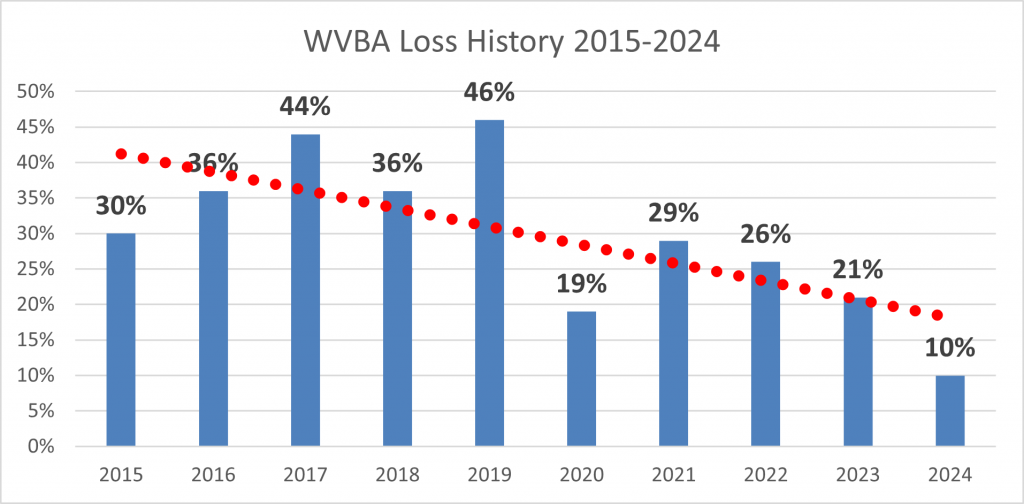WVBA members are encouraged to complete a web-based survey document in a continuing effort to define overwintering losses/successes of backyard beekeepers in Oregon. This was the 15th year of such survey activity. I received 171 reports from Oregon beekeepers keeping anywhere from 1 to 41 colonies; Willamette Valley members sent in 13 surveys, less than ½ the previous year (26) but an improvement of the low number the previous year when only 10 WVBA respondent surveys were returned. The average return for past 5 years = 22%. Oddly, the response pattern has been lower response in even-number years followed by greater response in odd-numbered years.
Overwintering losses of WVBA respondents = 9.5%, eleven and half percentage points better compared to last year and 10 and half percentage points below the 20% statewide loss level, the lowest loss in 15 survey years. A total of 137 hives were included in survey. All were hives of removable comb. Percent losses, determined by hive types were 5% for Langstroth 8-frame (2 of 45 fall colonies lost) and 0% for Langstroth 10-frames hives (47 total in fall); 3 of 7 nucs were lost (43%). No Top Bar or Warré hives were managed by the 13 respondents. Seven of 36 long hives perished (19%) and 1 of 4 double deep nucs also did not survive (25% loss).
Loss level of 9.5% is 22.4 percentage points below the WVBA average loss level of previous nine years (31.9%) and 28 percentage points below Oregon statewide 9-year average (37.5%). Statewide the loss rates of Langstroth 8 and 10 frame hives over the past 9 years has averaged 34.2% for 8 frame Langstroth hives and 37.7% loss for 10 frame hives respectively. Nuc losses are typically higher than losses of 8- or 10-frame Langstroth hives; the Nuc 9-year average loss is 45%.
Graph below illustrates the loss history of last 10 years. Dotted line in red shows trend. Obviously the loss levels are going in right direction.
The survey also asked for hive loss by hive origination. The members reported 15% loss of previously overwintered colonies, Three overwintered packages survived and all but one nuc (of 9) survived. No loss of 6 swarms and 6 splits were lost.
Seven individuals (41%) had no loss (58 colonies). None had total loss (heaviest lost percentage was 1 of 2 colonies 50%), Four individuals lost a single colony, one lost 2 colonies and one individual lost 7 colonies.
Not typical of the statewide data, a higher percentage of WVBA respondents had higher colony numbers. Three WVBA individuals (18% of respondents) had one to three colonies with a 17% loss – statewide 47% of respondents had 1-3 colonies and experienced a 34% loss. Another three WVBA individuals had 4 or 5 colonies (7% loss), 1 individual had 7 colonies (no loss) with six respondents with 12+ colonies (highest number =34 colonies) had 10% loss. Statewide, the 20 individuals with 10+ colonies lost 15%. The consistent trend has been as colony numbers increase the percent loss level decreases, both statewide and for WVBA members, although small response may mask this.
Statewide, as years of experience increase, the loss level percentage decreases. The three WVBA individuals with 1-3 years experience had 22% loss level, the single individual with 6 years experience had 8% loss level, the 5 individuals with 7-9 years experience had 4% loss level and the four individuals with 10+ years experience lost 14% of their 51 fall colonies.
We asked individuals why they thought they lost their colony. Multiple responses were possible. There were 11 total reasons offered by 10 individuals who had loss. Varroa and queen issues each had 3 selections. Two individuals indicated weak in fall and another two said starvation. One indicated poor wintering.
We asked about acceptable loss. Two individuals said none, 2 said 5%, 3 said 10%, the median (which was the actual loss level of WVBA members), 1 said 15%, 2 indicated 20% and one said 50%.
Why do colonies die?
There is no effortless way to verify reason(s) for colony loss. Colonies in the same apiary may die for varied reasons. Examination of dead colonies is, at best confusing, and, although some options may be ruled out, we are often left with two or more possible reasons for losses. There is a good deal of variance in opinion as to what might be an acceptable loss level. We are dealing with living animals which are constantly exposed to many different challenges, both in the natural environment and the beekeeper’s apiary.
Major factors in colony loss are mites and their enhancement of viruses especially DWV (deformed wing virus) and declining nutritional adequacy/forage and diseases. Pesticide exposure in the agricultural environment weakens colonies. Yellow jacket predation is a constant danger to weaker fall colonies, Management, especially learning proper bee care in the first years of beekeeping, remains a factor in losses. What effects our changing environment such as global warming and other factors, play in colony losses are not at all clear. There is no simple answer to explain the levels of current losses nor is it possible to demonstrate that they are necessarily excessive for all the issues facing honey bees in the current environment.
Management selections and losses
I asked in the survey for information about some managements practiced by respondents. The survey inquired about feeding practices, wintering preparations, sanitation measures utilized, screen bottom board usage, mite monitoring, both non-chemical and chemical mite control techniques and queens. Respondents could select multiple options and there was always a none and other selection possible. This analysis seeks to compare responses of this past season to previous survey years.
This analysis takes longer. With a small number of WVBA responses this year, I will only summarize the WVBA responses – the statewide numbers will be more meaningful to examine.
Thank you to all who sent back surveys.
.

